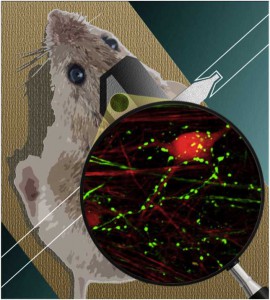CENTRAL DIRECTIONS
OF THE LAB
The goal of our research in the lab is to establish links between the organization of neural networks and the behaviors they generate. We carry out investigations into this outstanding issue through functional analysis of the mammalian hippocampal circuit, which produces spatial and episodic memories.
Organization of Hippocampal Memory Circuits
While our perceptual experience of the outside world is continuous, memory formation is restricted to specific important experiences – episodes – in our lives, allowing for most experience to be forgotten in favor of remembering informative events that can guide our future behavior. In mammals, the selective transformation of transient experience into stored memory occurs in the hippocampus, which develops representations of specific events in the context in which they occur. Despite substantial advances in our understanding of where memory is first formed, we still lack a mechanistic understanding of how hippocampal circuits support learning and memory formation. Our lab have sought to understand the neural basis of learning and memory particularly in mammalian brain, and have pursued this with experimental investigations into subcellular-, cellular- and network-level processes in the rodent hippocampus. The direction of our research is guided by a simple principle: in order to understand the complex behavioral phenomena of learning and memory formation, we need to provide an integrated and biophysically-based description of cortical memory-circuits during behavior, perhaps the grandest and most longstanding challenge of neuroscience. Therefore, while our lab has been continuing investigations into hippocampal circuits under exacting in vitro conditions (Lovett-Barron et al., Nature Neuroscience, 2012), we resolved to dedicate the central direction of our efforts towards establishing the missing links between these cellular/network processes and hippocampal-dependent memory behaviors, in order to establish the relevance of these computations for learning and memory formation in the behaving animal. These efforts demand recording methods with subcellular resolution, cell-type specificity, unbiased sampling, and with ability to track circuit activity throughout the course of learning.
This has prompted our lab to take the next steps for establishing novel high-resolution functional imaging and cell-type specific perturbations in the hippocampus of behaving mice, a novel approach that our group has deployed successfully in recent studies to dissect the role of identified hippocampal circuits in behaving animals (Kaifosh et al., Nature Neuroscience, 2013; Lovett-Barron et al., Science, 2014, Zaremba et al., Nature Neuroscience, Geiller et al., Neuron, 2020). These methods have positioned us to precisely monitor and manipulate individual identified synapses to populations of neurons together with rigorous behavioral control during the course of learning. Our current research focuses on the hippocampal area CA1, where concerted interactions among excitatory, inhibitory, and neuromodulatory circuit motifs produce the final output from the hippocampal circuit during behavior.
Our results obtained from these pioneering approaches have redefined our understanding of hippocampal circuit function in many ways, for instance, with respect to the types of information carried by subcortical inputs to the hippocampus at single synapse-level (Kaifosh et al., Nature Neuroscience, 2013), and to a novel and unexpected role of hippocampal inhibitory circuits in hippocampal contextual fear learning (Lovett-Barron et al., Science, 2014). These successes have encouraged us to expand our research program on other central and outstanding questions about cellular and circuit mechanisms of learning and memory formation in behaving animals. Our research is not strictly academic, but rather is of critical importance to public health. Our results will lead towards an integrated framework for understanding the pathophysiology of cognitive memory deficits in neurodegenerative and psychiatric disorders, where impaired function of hippocampal excitatory, inhibitory, and neuromodulatory functions have been widely posited.
Ongoing projects in the lab are aimed at dissecting and understanding:
- The hippocampal population code of spatial navigation and episodic learning in behaving animals
- The role of developmental and functional heterogeneity of principal cells and microcircuits in hippocampal learning and memory formation
- The role of hippocampal GABAergic circuits in spatial and episodic memory formation
- Subcortical neuromodulation in hippocampal learning and memory formation
- Connectivity maps of hippocampal microcircuits
- Hippocampal microcircuit dysfunctions underlying cognitive memory deficits in genetic mouse models of neuropsychiatric disorders.
- Altered hippocampal circuit dynamics in temporal lobe epilepsy.
Collaborators:
Boris Zemelman (UT Austin)
Ivan Soltesz (Stanford)
Alipasha Vaziri (Rockefeller)
Yiota Poirazi (IMBB-FORTH, Greece)
Gyorgy Buzsaki (NYU)
Franck Polleux (Columbia)
Stefano Fusi (Columbia)
Joseph Gogos (Columbia)